Dr. Dan Angelini, a research biologist at the Army's Combat Capabilities Development Command Chemical Biological Center, loads the lung chip into its medium supply system known as a "pod" at Aberdeen Proving Ground, Md., Oct. 21, 2020.
Providing up-to-date information, news and original content on American Military issues.
Dr. Dan Angelini, a research biologist at the Army's Combat Capabilities Development Command Chemical Biological Center, loads the lung chip into its medium supply system known as a "pod" at Aberdeen Proving Ground, Md., Oct. 21, 2020.
Marines participate in a close-air support training mission at Combined Arms Training Center Camp Fuji, Japan, Oct. 20, 2020.
Arizona National Guardsmen prepare boxes of groceries to be delivered to area residents at a kosher food bank in Phoenix, Ariz., Oct. 21, 2020. The Arizona National Guard has activated more than 800 citizen soldiers and airmen to support the community during the pandemic emergency response.
Oct. 22, 2020
Chief Pentagon Spokesman Jonathan Rath Hoffman provided the following readout:
Secretary of Defense Dr. Mark T. Esper met with Israeli Minister of Defense Benjamin Gantz at the Pentagon today.
The two leaders discussed the security and stability of the Middle East, as well as the United States’ long-standing and continuing commitment to maintaining Israel’s qualitative military edge.
Army Spc. Uriel Deniz participates in the land navigation course of the 224th Sustainment Brigade Best Warrior Competition in San Dimas, Calif., Oct. 16, 2020.
Marine Corps Staff Sgt. Ruben Arzate lowers a payload from an MV-22B Osprey to the ballistic missile submarine USS Henry M. Jackson around the Hawaiian Islands, Oct. 21, 2020.
The USS Iwo Jima fires a rolling airframe missile during surface warfare advanced tactical training in the Atlantic Ocean, Oct. 18, 2020.
Marine Corps Maj. David Cole II, right, and Cpl. Trevor Meegan exit an MV-22B Osprey during an exercise in Ajo, Ariz., Oct. 9, 2020.
Oct. 22, 2020
Secretary of Defense Dr. Mark T. Esper participated in his sixth NATO Defense Ministerial as the U.S. Defense Secretary today, providing remarks during a session where Allies focused on strengthening deterrence and defense, and improving resilience.
The Secretary focused on strengthening deterrence and defense, equitable burden sharing, and Alliance unity, using the Department’s new initiative, the “Guidance for Development of Alliances and Partnerships,” as a guide for the discussion.
The Secretary discussed challenges posed by increased Russian aggression, including concerns over their growing missile capabilities. He also addressed the risks of depending on the People’s Republic of China for technology and critical infrastructure as they continue to undermine the international global order.
Secretary Esper welcomed the progress that Allies have made towards acquiring and strengthening conventional capabilities. He also emphasized the importance of fulfilling NATO-assigned capability targets to ensure NATO has the ready forces and equipment necessary to deter and counter any threat.
Secretary Esper reiterated the importance of all Allies meeting the goals of the 2014 Wales Defense Investment Pledge, including spending two percent of GDP on defense, even as the Alliance faces challenging economic times during the COVID pandemic. He also welcomed the announcement that 2020 marks the sixth consecutive year of increased Allied defense spending.
Secretary Esper reaffirmed the U.S. commitment to and confidence in the NATO Alliance as we confront the security challenges of the 21st century.
Oct. 22, 2020 | BY USD(R&E) and JS,JFIC
To achieve our National Defense Strategy goals, the Defense Department must increase the pace by which critical technologies are integrated into the force. According to officials with the Director of Defense Research and Engineering (Advanced Capabilities) and Joint Staff, Joint Force Integration Cell, the Deputy Director for Engineering, in the Office of the Under Secretary of Defense for Research and Engineering, is working with stakeholders from the Joint Staff and services to implement mission engineering methodologies to facilitate technology integration aligned with future Joint Force needs.
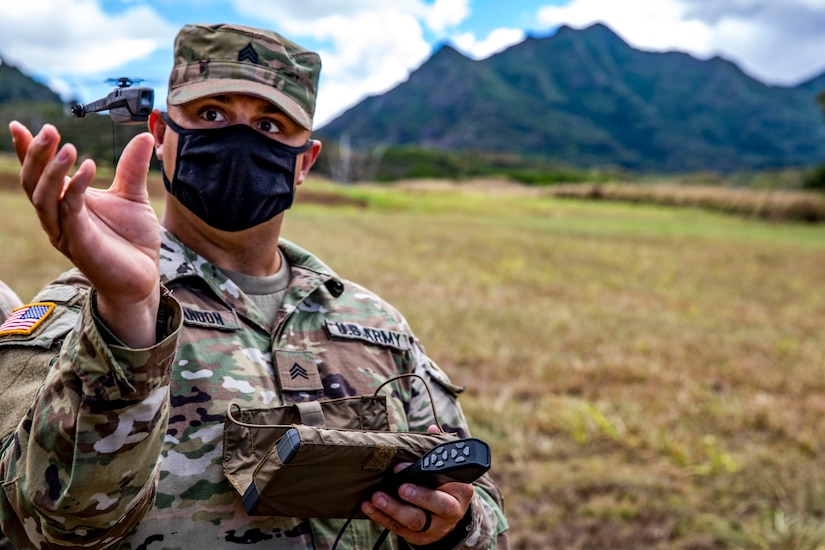
Where systems engineering helps "build things right," ME ensures we are "building the right things." ME, as defined in the forthcoming DoD Mission Engineering Guide being released by R&E, is "the deliberate planning, analyzing, organizing, and integrating of current and emerging operational and system capabilities to achieve desired warfighting mission effects." The officials said ME analyzes systems and systems of systems in an operational mission context to evaluate capability solutions, advise on the development of requirements and inform technology investment decisions.
Officials added that R&E is currently involved in various activities aligned to the National Defense Strategy modernization areas and in support of the Joint Staff. R&E's ME framework focuses on desired activities and effects rather than the current pipeline of programs and systems, using mission capability as the measuring stick to make it easier to decide on technology investments. It provides a systematic method to analyze, communicate, and compare joint warfighting concepts. It starts by defining and inputting the activities, assumptions, dependencies, threats and gaps within a concept's "mission area" future scenario. Then, using metrics and other indicators, it examines mission threads and effects-chains to quantify improvement and expose gaps between current and future technologies through tradeoff analysis.

The R&E is working with the Joint Staff and other stakeholders to apply this methodology to help guide the Joint Warfighting Concept (JWC), said the officials. The JWC's supporting concepts are emerging, threat-informed constructs to codify globally integrated operations encompassing all-domain maneuver warfare — supported by leading-edge concepts in command and control, joint fires, information assurance and contested logistics — enhanced by integrated capabilities in space, cyber, and electromagnetic spectrum dominance. By setting the JWC in a common analytical framework, it can validate (or invalidate) assumptions and untangle complex and intertwined dependencies. Mission blueprints and enterprise architectures are the products that capture these dependencies, future constructs, and performance needs.
Additionally, R&E co-chairs the Joint All Domain Command Control (JADC2) Research and Engineering/Reference Architecture Working Group. R&E, in coordination with J6, is conducting ME to apply analytical and technical rigor in a mission context to identify JADC2 capabilities and requirements and inform investment decisions for research and development initiatives. The results will support the development of the JADC2 reference architecture which provides the foundation to connect distributed sensors, shooters and data across all domains to all forces, the officials added.
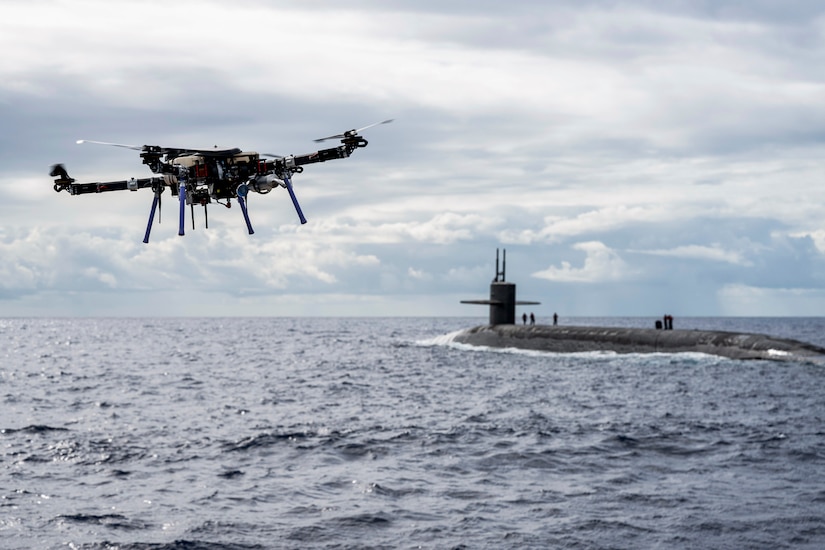
ME products are already making a significant impact by providing data-driven "mission blueprints," as well as government reference architectures that help decision makers ensure research, technology and programs converge in the proper timeframes. The officials said that applied to JADC2, FNC3 and other technical focus areas, the R&E's principal directors for modernization can apply ME to guide the maturation of capabilities that deliver the highest mission efficacy and mission return on investment.
The officials said to face the challenges of this century, and give U.S. warfighters the technological edge they need to effectively confront near-peer competitors, the Defense Department must embrace a new approach to joint capability modernization. ME and related tools like the ME Framework will help instill engineering rigor into the technology and acquisition pipelines, with the promise of keeping U.S. forces relevant and dominant in the rapidly evolving battlespace of the coming decades.
Oct. 22, 2020 | BY Jim Garamone , DOD News
During an impromptu press conference, Defense Secretary Dr. Mark. T. Esper reaffirmed the U.S. commitment to maintain Israel's qualitative superiority in weapons sales.
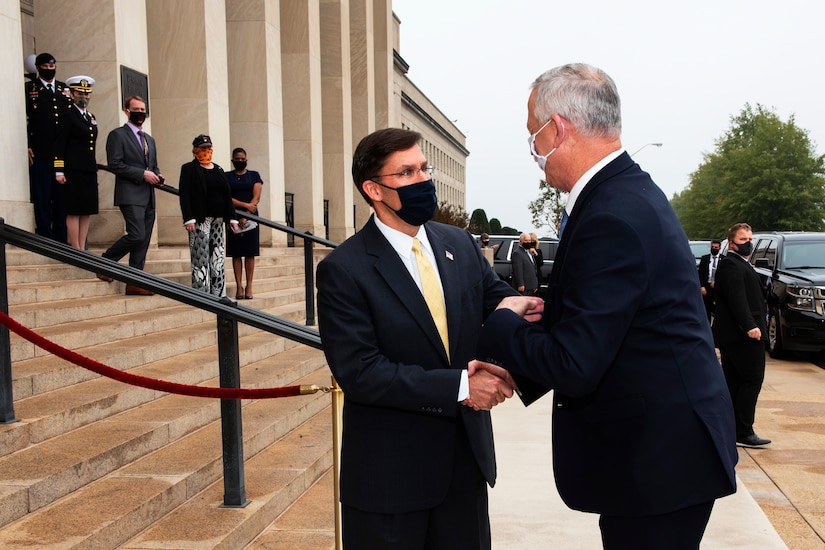
Esper repeated the American commitment after meeting with Israeli Defense Minister Benny Gantz in the Pentagon. It was the second visit of the future Israeli prime minister to the Pentagon in less than a month.
"It was important for me once again to reaffirm the special relationship between our two countries, the commitment we made to Israel security that's based on our shared values, our shared history and the commonalities between our two peoples," Esper said. " I want to thank you for your personal efforts in the past few weeks, and I want to state again, how committed we are to Israel's qualitative military edge when it comes to defense sales, and our commitment to Israel security, which has been long-standing and guaranteed and ironclad."
Gantz thanked the secretary for the guarantees and praised the bipartisan consensus around aid to Israel. "I want to thank the American administration for supporting it," Gantz said. "Now that we are entering an era of good and positive normalization processes in the Middle East, which actually can face aggressive Iran over all the region. This … continued cooperation, I would say, is so very important."
Oct. 22, 2020 | BY COURTESY OF 436TH AIRLIFT WING PUBLIC AFFAIRS
Dover Air Force Base is the first Air Mobility Command base to conduct an event known as Ready EAGLE, or readiness exercises and assessments in a goal-oriented learning environment.
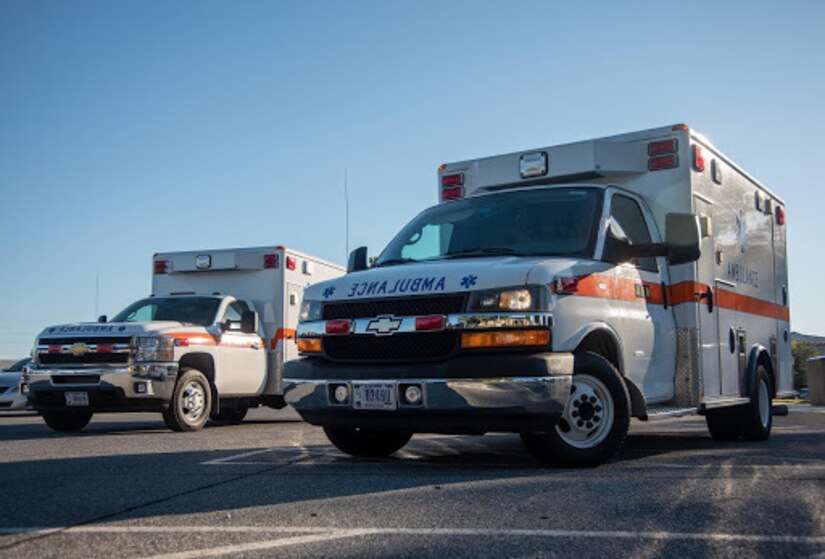
The base's Medical Contingency Response Program team and other units of the 436th Medical Group participated in Ready EAGLE.
First developed in 2019, Ready EAGLE is an initiative developed by the Air Force Medical Service preparedness and response oversight committee to reinvigorate installation medical response programs.
"Ready EAGLE is about developing the confidence and skill set to enhance our response capability," Lt. Col. Kristen Carter, commander of the 436th Medical Support Squadron, said. "It's designed as a crawl-walk-run program with seminars, equipment reviews and tabletops leading to a full-scale exercise at the end of the week, all designed to enhance our response capability."
Ready EAGLE implements robust, hands-on tools and training in support of full-spectrum medical readiness, Air Force Maj. Harold Brown, 436th Medical Support Squadron medical readiness officer, said. Brown and his readiness team facilitated the Ready EAGLE visit.
"We've been working with our [major command point-of-contact] and our Ready EAGLE team for over a year, and my readiness office has been working diligently with the base, wing and our counterparts at [the] MAJCOM to make sure this is a success," Brown said.
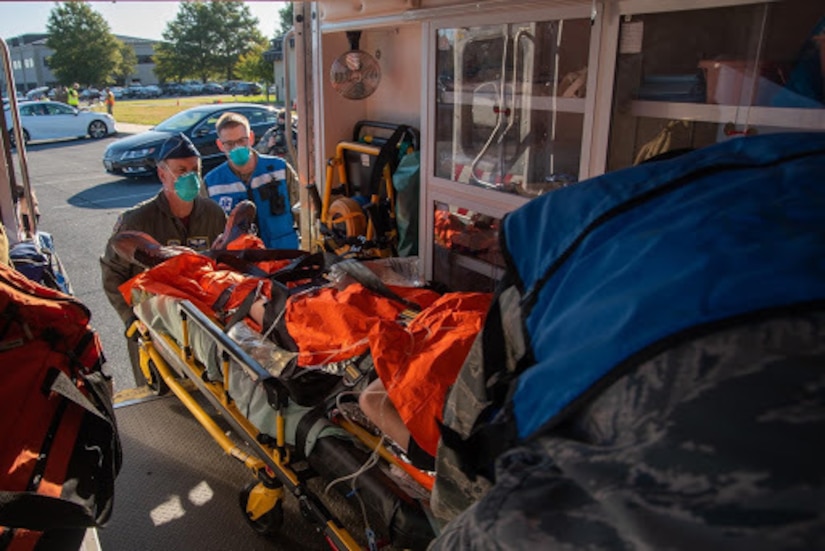
Airmen who participated gained skills in patient decontamination, patient tracking, triage, disease containment and much more.
Ready EAGLE prepares the Air Force's medical assets for installation medical response to all hazards, including chemical, biological, radiological and nuclear incidents.
"Training, lesson plans and other tools … give Air Force medics the ability to have the confidence and the cohesion that we need so much," Martin Schelling, Air Mobility Command medical emergency manager, said. "So, as you go from Air Force facility to Air Force facility, it is the same skills and the same program."
The COVID-19 pandemic presented new challenges while planning Ready EAGLE. Participants wore masks and socially distanced themselves to help mitigate the risk of exposure to COVID-19.
"The COVID-19 crisis has dynamically changed our entire world," Schelling said. "When we were confronted with this crisis, we naturally wanted to rely on our planning and training that we had performed for years. We've had to go on a six- or seven-month hiatus from doing hands-on exercises and training."
To mitigate the risk of COVID-19, the 436th Medical Group ensured that all participants wore masks and provided larger venues to allow for social distancing.
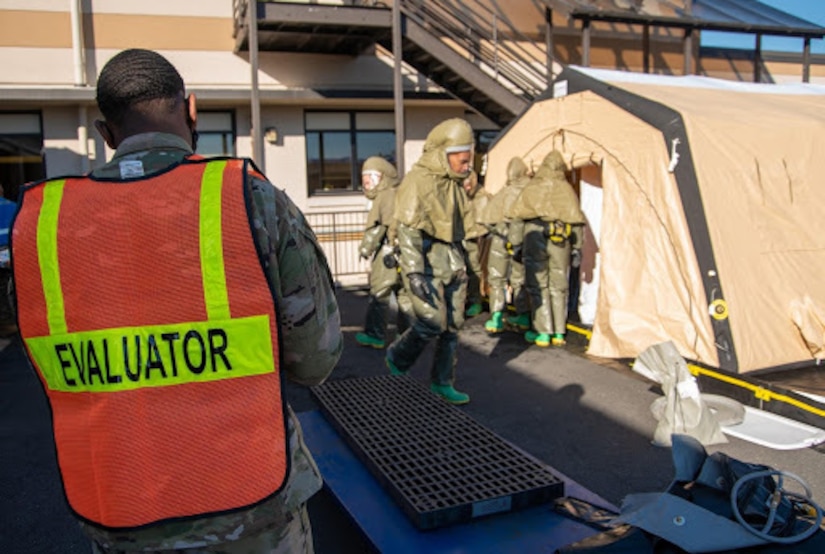
The 436th Medical Group even implemented COVID-19 response scenarios
into Ready EAGLE, including a public health training session that
addresses outbreak investigation procedures.
Ready EAGLE was a collaborative effort that required help from volunteers throughout the base.
"With an event of this magnitude, there are a lot of moving parts,"
Brown said. "Some of the challenges include securing the locations for
the breakout sessions and finding volunteers. We've reached out across
the wing to help with these challenges."
After considerable planning, collaboration and adjustments to COVID-19,
Dover Air Force Base and other participating bases have found a way to
continue preparing for its medical readiness.
"Ready EAGLE is the best way … to take our Air Force medics to a new level," Schelling said.
Oct. 21, 2020 | BY Jim Garamone , DOD News
Lee Kelley, the director of the military community support programs, discussed the need for such programs during a recent interview.
Kelley is intimately familiar with the problem having been detailed to serve as the deputy director for the Defense Suicide Prevention Office. In studying the complex nature of suicide, the Defense Department has found that relationships are a top contributing factor.
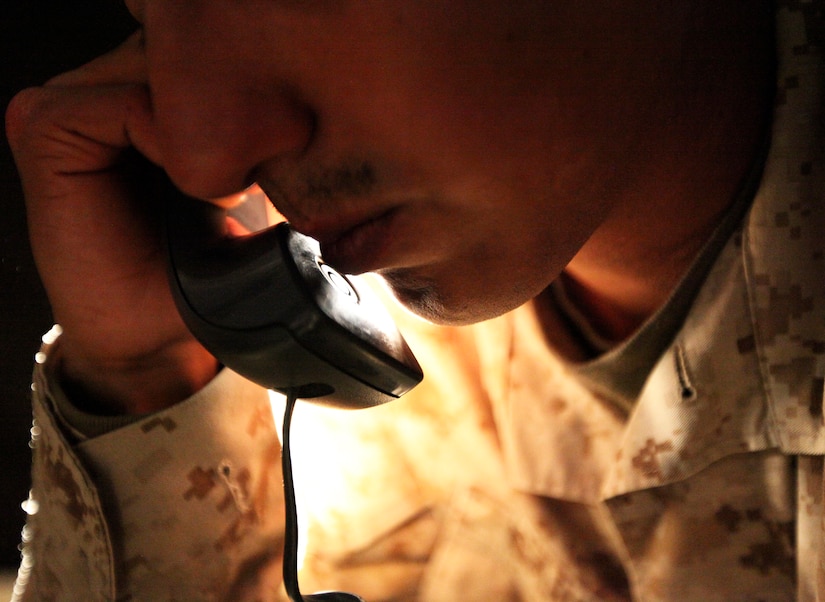
Beyond that, "relationships are the top reason that service members and families seek non-medical counseling through some of the programs that I work with," she said.
Kelley went back to her regular job and gathered a group of experts to examine the type of relationship support being provided to the community across the DOD around the world. "Through the course of this deep dive group, research was brought up about different relationship interventions that have shown promising results in the military community," she said.
The relationship campaign for service members and military families has been launched.
In the civilian world, most couples have families nearby or a network of friends they can confide in, Kelley said . There are churches or medical personnel they can turn to. Many times in the military situation, service members may feel there is no support group.
But there is, Kelley says, and she wants service members to know they are not alone, and there are ways to get that support.
"First of all, we want them to know that they should be comfortable seeking support through our counselors," she said. "What we're doing as a first part of the campaign is pulling back the curtain on what relationship support looks like. What is it? What does it even look like to sit down with a counselor? What kinds of questions are they going to ask me? Does it mean my relationships [are] over if I sit down with a counselor or ask for help?"
Service providers, like the military and family life counselors, will post on social media to talk about what relationship support looks like, what it sounds like, what it feels like, with the end goal being to normalize the experience of seeking help for a relationship, she said.
The second phase of the program is to define what skills an individual can build on to find success in relationships or recover when a relationship doesn't work out, she said.
Kelley is clear-eyed about what can be accomplished. She knows that break-ups happen. "The worst thing that we can hear is that we may have a junior enlisted service member on the East Coast, and their significant other breaks up with them via text message from the other side of the country," she said. "We don't want that service member to feel alone. We don't want that service member to feel like there's no tomorrow. There are alternatives."
And service members and their families are responding. In fiscal 2019, counsellors conducted more than 260,000 relationship sessions through the military and family life counseling program. The program is accessible "to all of our active duty, National Guard and Reserve service members and families, regardless of activation status from anywhere around the world," Kelley said.
COVID-19 has forced some changes, and telehealth counseling is part of the process. Kelley said there has been an uptick in couples seeking counseling since the start of the pandemic, but it is continuing the rise the office saw in previous years. COVID-19 is also forcing couples to confront their problems in ways they might not have done in the past, she said.
Information is at Military OneSource at 1-800-342-9647. There is also an opportunity for a live chat on the website, militaryonesource.mil.